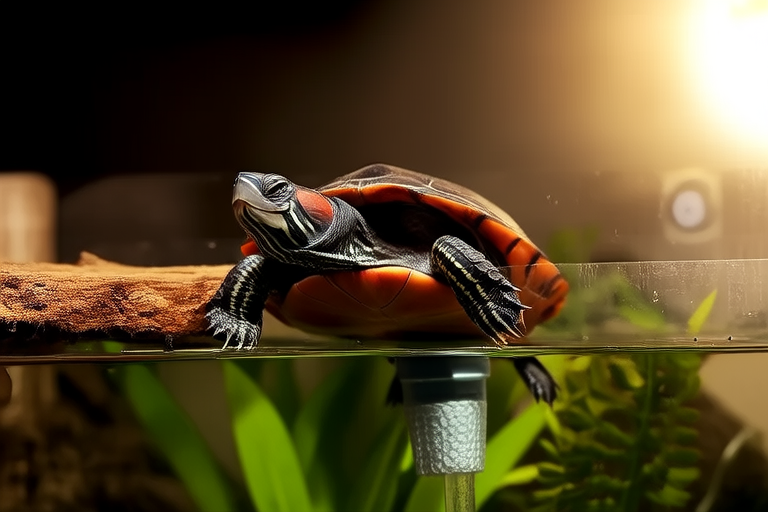How to Create the Perfect Habitat for Your Red-Eared Slider
Welcome to your ultimate guide on creating the perfect habitat for your red-eared slider! These turtles are fascinating creatures that require specific care to thrive. This comprehensive article will walk you through the essential elements of setting up their home, including ideal tank size, proper heating and lighting, water quality maintenance, substrate options, decorations, diet specifics, health checks, and safety precautions.
Ideal Tank Size
The first step in creating a perfect habitat for your red-eared slider is ensuring you have an appropriate tank size. A young turtle can live comfortably in a 20-gallon tank, but as they grow, so should their living space. By the time your turtle reaches adulthood, it will need at least 40 gallons of water per inch of shell length. For example, a fully grown turtle with a 6-inch shell would require a minimum of 240 gallons of water. It’s important to provide ample space to allow your turtle to swim and explore freely.
Proper Heating and Lighting Requirements
Heating and lighting are crucial for maintaining your turtle’s health. Red-eared sliders require both heat lamps and UVB lights. Heat lamps should be placed above one side of the tank to create a basking area, where the temperature should reach around 85-90°F (29-32°C). The opposite end of the tank should remain cooler, ideally between 75-80°F (24-27°C), allowing your turtle to regulate its body temperature by moving between the warm and cool areas.
UVB light is equally important for your turtle’s health. UVB helps them synthesize vitamin D3, which is necessary for calcium absorption. Ensure that the UVB light is placed within 12 inches of the basking area and replace it every six months or as directed by the manufacturer. Keep in mind that UVB light does not pass through glass or plastic, so make sure your turtle has direct access to the light source.
Necessary Water Quality Maintenance
Water quality is critical for your red-eared slider’s well-being. Regular water changes are essential to maintain clean and healthy conditions. Aim to change 25% of the water weekly and perform a full tank cleaning every two weeks. Use a high-quality aquarium filter designed for large tanks to help maintain water clarity and reduce the frequency of water changes.
Monitor water parameters such as pH, ammonia, nitrite, and nitrate levels regularly. Red-eared sliders prefer slightly alkaline water with a pH between 7.0 and 8.5. Ammonia and nitrite levels should always be zero, while nitrate levels should be kept below 40 ppm. To achieve these optimal conditions, consider using water conditioners specifically formulated for reptile habitats.
Suitable Substrate Options
The choice of substrate can affect the cleanliness of your turtle’s environment. Gravel is often avoided because small pieces can be accidentally ingested, leading to blockages. Instead, opt for larger gravel or smooth pebbles that are too big to be swallowed. Another popular option is silicone-based aquarium sand, which is safe and easy to clean. Avoid substrates that can scratch your turtle’s shell or cause irritation.
Recommended Decorations for Hiding and Basking
Your turtle needs both a basking area and places to hide. Provide a sturdy platform that allows your turtle to climb out of the water and bask under the heat lamp. Ensure the platform is stable and provides a dry surface. You can also add floating platforms or logs for additional basking spots.
To create hiding spots, incorporate caves, tunnels, or artificial plants. These not only provide shelter but also stimulate natural behaviors. Be cautious when selecting decorations; avoid anything that could trap your turtle or cause injury. Natural driftwood and rocks can also be used, but ensure they are firmly anchored to prevent accidents.
Diet Specifics
A balanced diet is key to keeping your red-eared slider healthy. Offer a variety of foods, including commercial turtle pellets, leafy greens, and occasional treats like earthworms or feeder fish. Feed your turtle daily, but limit the amount to what they can consume in about 15 minutes. Overfeeding can lead to obesity and other health issues. Additionally, ensure your turtle has access to fresh water for drinking.
Vitamin supplements may be necessary if your turtle’s diet lacks essential nutrients. Consult with a veterinarian experienced in reptile care to determine if supplementation is needed and the correct dosage.
Regular Health Checks
Regular health checks are vital for early detection of potential issues. Look for signs of illness such as lethargy, loss of appetite, swollen eyes, or respiratory distress. If you notice any concerning symptoms, consult a veterinarian immediately.
Annual veterinary check-ups are also recommended. During these visits, your vet can perform a thorough examination, check blood work, and ensure your turtle is receiving the proper care.
Safety Precautions
Ensure your turtle’s habitat is secure to prevent escapes and injuries. The tank should have a tight-fitting lid or cover to keep your turtle inside. Also, make sure all electrical cords are safely tucked away and out of reach.
Avoid handling your turtle too frequently, as this can stress them. When you do handle them, support their entire body and avoid lifting them by the shell or limbs. Always wash your hands before and after handling to prevent the spread of bacteria.
By following these guidelines, you’ll be well on your way to providing a thriving environment for your red-eared slider. Remember, creating the perfect habitat requires attention to detail and ongoing maintenance. With dedication and care, your turtle will enjoy a long and healthy life. Happy turtle-keeping!
